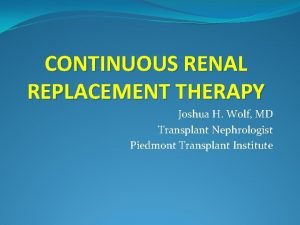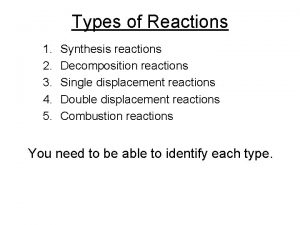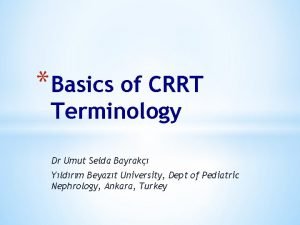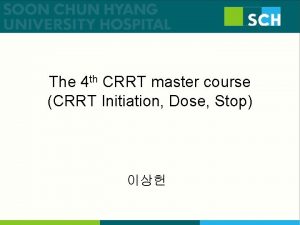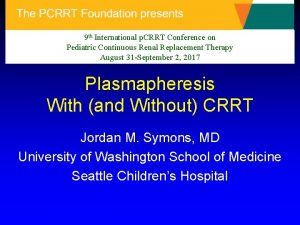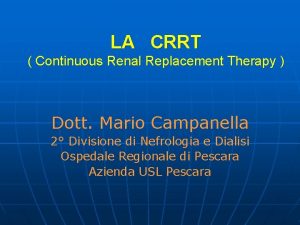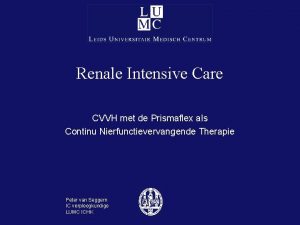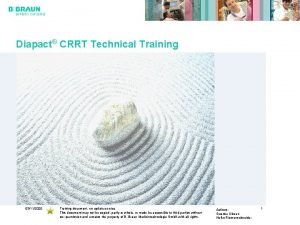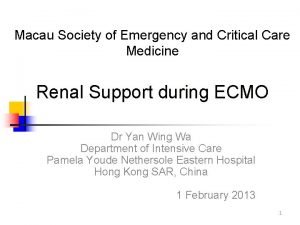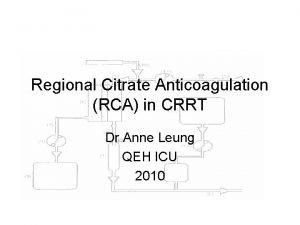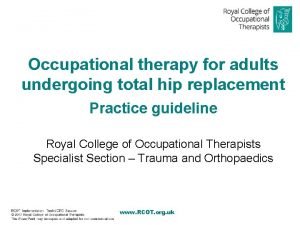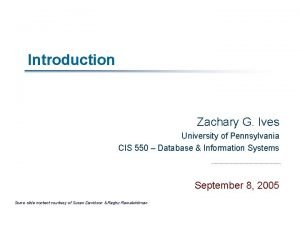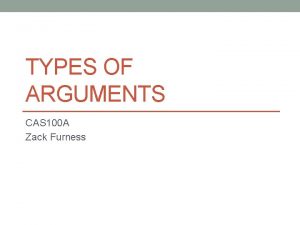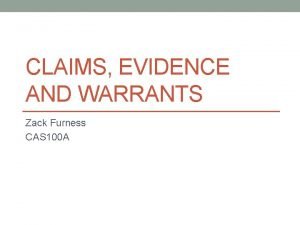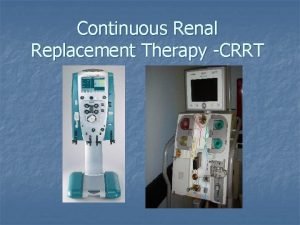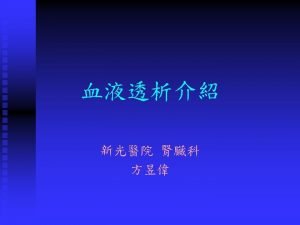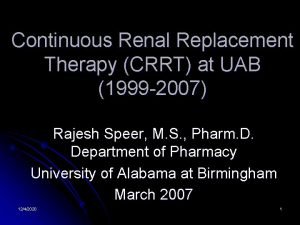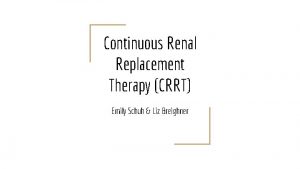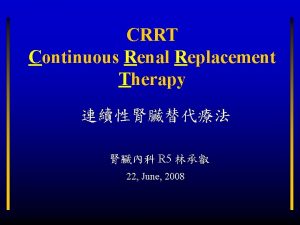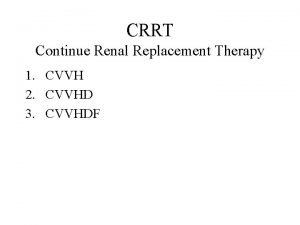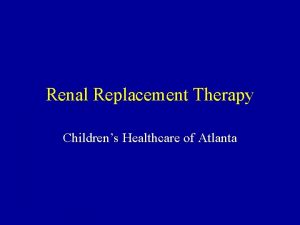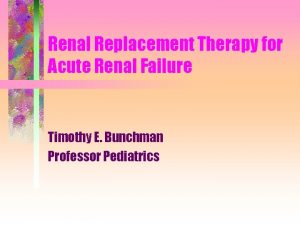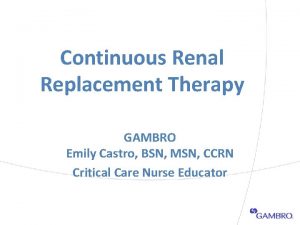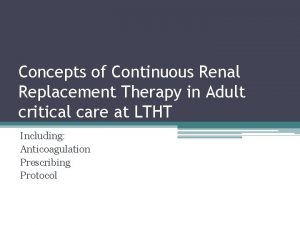Continuous Renal Replacement Therapy CRRT Annette Fernandez Zack























- Slides: 23

Continuous Renal Replacement Therapy (CRRT) Annette Fernandez, Zack Hedrick, Kristin Toliver, Jasmine Wells NURS 451: Clinical Management of Adult Health Nursing III Sentara Princess Anne Hospital

Learner Goals and Objectives • Identify what diseases can lead to the implementation of CRRT • Discuss dialysis and CRRT, and identify the difference between dialysis and CRRT • Identify medications used for patients on CRRT and lab values to monitor • Identify complications of CRRT and precautions to take while monitoring patients on CRRT

Case Study • B. V. is a 29 year old male who is a native of Guatemala, only Spanish speaking, and no family in the area except for a cousin, and has a history of Alcohol abuse • Presented to the ED with abdominal pain and distension, vomiting, diarrhea, HR 101, increased work of breathing, crackles, and diminished breath sounds • EKG shows peaked T waves; Chest x-ray reveals pleural effusion; Amylase and Lipase are elevated. • BV went into respiratory failure, was intubated and mechanically ventilated, then admitted to the ICU for further monitoring.

B. V. has Acute Pancreatitis • His symptoms are clinical manifestations of pancreatitis. • BV was also found to be in acute renal failure. • Diagnostic tests for pancreatitis, amylase and lipase, were elevated. • CT of the abdomen showed an acutely inflamed pancreas • Pancreatic enzymes induce inflammation of his diaphragm. • Movement of the diaphragm decreases and fluid shifts.

Acute Renal Failure (ARF) • Associated with mortality of 15 -60% • Co-existing non-kidney conditions • Prerenal • Any condition that decreases blood flow, blood pressure or kidney perfusion i. e. , abdominal compartment syndrome • Intrarenal • Any condition that produces an ischemic or toxic insult directly at parenchymal nephron tissue i. e. , pancreatitis & use of contrast dye • Postrenal • Any obstruction that hinders the flow of urine from beyond the kidney through the remainder of the urinary tract i. e. , kidney stones

Pancreatitis Related to ARF • Two most common causes: gallstone migration and alcoholism • Normally inactive enzymes prematurely activated autodigestion of pancreatic tissue • Obstruction of or damage to pancreatic duct system, alterations in secretory process, infection, ischemia • Release of enzymes increased capillary membrane permeability leakage of fluid into interstitium edema & relative hypovolemia • Elastase dissolves elastic fibers of blood vessels and ducts hemorrhage • Other enzymes destruction of phospholipids of cell membranes pancreatic and adipose tissue necrosis

Patients with ARF r/t Pancreatitis • Mortality rate of patients with ARF 58% - 74. 7% • Examine risk factors of ARF, prognosis, and seek preventative measures • Hypoxemia is a significant risk factor • Amylase released from pancreas may impair renal microcirculation – ischemia • Abdominal compartment syndrome – significant risk factor of ARF: ascites & bowel ileus • Increased abdominal pressure reduces blood supply to other organs – poor kidney perfusion

Indications for CRRT • Need for large fluid removal in hemodynamically unstable patient • Hypervolemic or edematous patients unresponsive to diuretic therapy • Patients with MODS • Ease of fluid management • Patients that cannot tolerate hemodialysis or peritoneal dialysis • Inability to be anticoagulated

CRRT • CRRT is a newer mode of dialysis • Continuous Renal Replacement Therapies (CRRT) are dialysis treatments that are provided as a continuous 24 hour per day therapy. (Sarkar, 2009) • Monitored by a CC nurse and may last many days • Venous blood is circulated through a highly porous hemofilter • CRRT allows for continuous removal of fluid from the plasma • Critically ill patients are hypotensive and cannot provide adequate flow through the hemofilter, an electric roller pump milks the tubing to augment flow • So CRRT is a mode of renal replacement therapy for hemodynamically unstable, fluid overloaded, catabolic septic patients and finds its application in management of acute renal failure especially in the critical care /intensive care unit setting.

Dialysis vs CRRT • Hemodialysis is 3 -4 times per week whereas CRRT is continuous • Both hemo and CRRT – access and return of blood are achieved through a large venous catheter, and use a semipermeable membrane • CRRT uses an electric pump to milk the tubing and augment flow as MAP may not be sufficient to pump blood through filter • CRRT may be better tolerated than HD by critically ill patients because this method avoids rapid shifts of fluids and electrolytes • Procedures for CRRT are similar to HD but are temporary • The major difference between intermittent and continuous therapies is the speed at which water and wastes are removed. • Intermittent hemodialysis removes large amounts of water and wastes in a short period of time, whereas, continuous renal replacement therapies remove water and wastes at a slow and steady rate.

Pro’s and Con’s of CRRT • Advantages • CRRT by its lower rate of fluid removal can lead to steady state fluid equilibrium in hemodynamically unstable, critically ill patients with associated comorbid conditions • It provides excellent control of azotemia, electrolytes and acid base balance. These patients are catabolic thus, removal of urea is mandatory to effectively control azotemia. • CRRT can help in administration of parenteral nutrition and obligatory I. V medications like pressors & inotropes by creating an unlimited space by virtue of Continuous ultrafiltration. • Disadvantages • This mode of therapy requires regular monitoring of hemodynamic status and fluid balance (ultrafiltration rate, replacement fluid); regular infusion of dialysate; continuous anticoagulation; ongoing alarms and an expensive mode of therapy above all.

How CRRT Works

Medications While on CRRT • Maintain Hemodynamic Stability • • Usually Hypotensive- give Vasopressors Levophed, Neosynepherine, Vasopressin Helps adequate flow/pressure through hemofilter. Maintain a MAP > 70 • Electrolyte Replacement • Correct any electrolyte imbalance. • Calcium Chloride, magnesium sulfate, potassium chloride • Fluid Replacement • Large volumes of fluid being removed, called ultrafiltrate. • Needs to be replaced to avoid intravascular dehydration.

Medications Cont. • Anticoagulation • Needed to maintain patency of pump, keep hemofilter from becoming obstructed. • Dose should be low, Systemic anticoagulation is not the goal. • Heparin and Citrate • Dialysate Formula • Used to help filter wastes • Prismasate: bicarbonate-based solution, helps control acid-base balance • Contains electrolytes • Insulin • Dialysates have high levels of glucose • Ketoacidosis

Lab Values to Monitor • Electrolyte Levels • Potassium, magnesium, sodium, calcium, phosphorus • BUN and Creatinine levels • • • Decides if CRRT is needed CRRT is prescribed when BUN is approximately 60 mg/d. L. CRRT is usually done before BUN reaches 90 and creatinine exceeds 9 mg/d. L. Fluid overload and severe electrolyte imbalance may require earlier intervention. PTT and Platelet levels • Abnormalities with these may indicate risk for bleeding. • Pancreatic enzyme levels • Lipase, Amylase, higher production due to the pancreatitis

Complications of CRRT • Decreased Ultrafiltration Rate • Filter clotting • Hypotension • Fluid/Electrolyte imbalance – Edema • Bleeding • Access dislodgement – Infection • Hypothermia

Nursing Interventions • Decreased Ultrafiltration Rate – Lower height of collection container, position pt on back, control coagulation time • Filter clotting – Control/maintain anticoagulation (heparin/citrate), Call physician, remove system, prime catheters with anticoagulation solution, Prime new system, Start predilution with 1 L NS per hour • Hypotension – Control amount of ultrafiltration, control access site, clamp lines

Nursing Interventions Cont. • F&E imbalance – Observe for changes in CVP, vitals, and ECG, monitor output values q hour, control ultrafiltration • Bleeding – Monitor calcium if using citrate, monitor PTT (heparin) values q hr and adjust dose within parameters to maintain anticoagulation, Observe dressing and filtrate for evidence of blood loss • Dislodgement/Infection – Strict sterile technique when dressing vascular access, observe access site q 2 hr, and have clamps available and within reach at all times

Prevention of Complications • The nurse should: – Monitor fluid intake and output every hour (daily weights are important) – Detects potential complications (bleeding, hypotension, hypothermia, and infection) – Identify trends in electrolyte laboratory values (calcium, potassium, sodium; also BUN and Creatinine) – Make sure the operation of the CRRT equipment is safe – Provide patient and family education about the use of CRRT and condition

Conclusion • Pancreatitis among other disease processes can lead to ARF which may result in CRRT implementation • CRRT is continuous but temporary for critically ill patients that are hemodynamically unstable • Hemodynamic stability and electrolyte replacement is the main focus of medication administration and the monitoring of lab values • It is the nurses responsibility to monitor a CRRT patient for potential complications, implement the appropriate actions, and promote the patients safety during treatment

Objectives Reviewed • Identified what diseases can lead to the implementation of CRRT • Discussed dialysis and CRRT, and identified the difference between dialysis and CRRT • Identified medications used for patients on CRRT and lab values to monitor • Identified complications of CRRT and precautions to take while monitoring patients on CRRT

References Baxter. (2013). Continuous renal replacement therapy (crrt). Retrieved from http: //www. baxter. com/healthcare _ professionals/therapies/renal/acute_kidney_treatment/ continuous_renal_replacement_therapy. html Chaturvedi, M. (2004). Continuous renal replacement therapy (crrt). Retrieved from http: //lane. stanford. edu/portals/cvicu/ HCP_GU_Tab_3/Intro_to_CRRT. pdf Craven, R. F. , & Hirnle, C. J. (2009). Fundamentals of nursing. (6 th ed. ). Philadelphia, PA: Lippincott Williams, & Wilkins. Urden, L. D. , Stacey, K. M. , & Lough, M. E. (2010). Critical care nursing diagnosis and management. (6 th ed. ). St Louis MO: Mosby Elsevier.

References Cont. Ignatavicius, D. D. , & Workman, M. L. (2013). Medical-surgical nursing: Patient centered collaborative care. (7 th ed. ). St Louis MO: Elsevier Inc. Sarkar, S. (2009). Continuous renal replacement therapy (CRRT). Internet Journal Of Anesthesiology, 21(1) Tillman, J. (2009). Heparin versus citrate for anticoagulation in critically ill patients treated with continuous renal replacement therapy. Nursing In Critical Care, 14(4), 191199. doi: 10. 1111/j. 1478 -5153. 2009. 00339. x
 Ira pré renal renal e pós renal
Ira pré renal renal e pós renal Teoria do nefron intacto
Teoria do nefron intacto Aeiou renal replacement therapy
Aeiou renal replacement therapy Cortical and juxtamedullary nephrons difference
Cortical and juxtamedullary nephrons difference Na o cl
Na o cl Diapact crrt
Diapact crrt Crrt troubleshooting
Crrt troubleshooting Crrt training course
Crrt training course Crrt conference
Crrt conference Crrt training course 2020
Crrt training course 2020 Cvvhdf+impostazione parametri
Cvvhdf+impostazione parametri Scuf dialyse
Scuf dialyse Diapact crrt
Diapact crrt Crrt for dummies
Crrt for dummies Crrtdr.shop
Crrtdr.shop Occupational therapy intervention plan for hip arthroplasty
Occupational therapy intervention plan for hip arthroplasty Nicotine replacement therapy side effects
Nicotine replacement therapy side effects Electrolyte replacement therapy
Electrolyte replacement therapy Zack weinberg cmu
Zack weinberg cmu Zack ives
Zack ives Zack wolf
Zack wolf Zack olson md
Zack olson md Furness definition
Furness definition Evidence and claim examples
Evidence and claim examples


